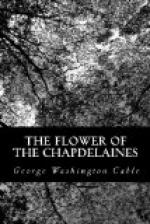Strangest, wildest practice of the slaves was the hideous misuse Christian masters allowed them to make of Chrismas Day and week. It was then they danced the bamboula, incessantly. All through the year this Saturnalia was prepared for in meetings held at night by their leaders. The songs to which they danced were made of white society’s scandals reduced to satirical rhyme; and to the rashest girl or man there was power in the warning, “You’ll get yourself sung about at Christmas.” Yearly a king, queen, and retinue were elected. The dresses of court and all were a mixture of splendor and tawdriness that exhausted the savings and pilferings of a twelvemonth. Good-natured “missies” often helped make these outfits. They were of velvet, silk, satin, cotton lace, false flowers, the brilliant seeds of the licorice and coquelicot, tinsel, beads, and pinch-beck. Sometimes mistresses even lent—firmly sewed fast—their own jewelry.
On Christmas Eve, here and there in the town, ground-floor rooms were hired and decorated with palm branches; or palm booths were built, decked with oranges and boughs of cinnamon berries, lighted with candles and lanterns and furnished with seats for the king, queen, and musicians, and with buckets of rum punch. Then the “bulrush man” went his round. Covered with capes and flounces of rushes and crowned with a high waving fringe of them, he rattled pebbles in calabashes, danced to their clatter, proclaimed the feast, and begged such of us white children as his dress did not terrify, for stivers from our holiday savings.
Soon the dancers began to gather in the booths; women in gorgeous trailing gowns, the men bearing showy batons and clad in gay shirts or satin jackets, and with a mongrel infant rabble at their heels. When the goombay—a flour-barrel drum—sounded, the town knew the bamboula had begun. On two confronting lines, the men in one, the women in the other, a leading couple improvised a song and all took up the refrain. The goombay beat time, and the dancers rattled or tinkled the woody seed-cases of the sand-box tree set on long handles and with each of their lobes painted a separate vivid color; rattles of basketwork; and calabashes filled with pebbles and shells. All instruments were gay with floating ribbons. So the lines approached each other by two steps, receded, advanced, and receded, always in wild cadence to the signals of voice and instrument; then bowed so low that they touched—twice—thrice; then pirouetted and resumed the first movement, and now and then, with two or three turns or bows, clashed their rattles together in time. As night darkened, the rude lights flared yellow and red upon the dusky forms bedizened with beads, bangles, and grotesquer trumpery. Faces, necks, arms reeked and shone in the heat, ribbons streamed, gross odors arose, the goombay dominated all, and children of the master race—for even I was permitted to witness these orgies—without comprehending, stood aghast. Close outside, the matchless night lay on land and sea; a relieved sense caught ethereal perfumes and was soothed by the exquisite refinement into whose space and silence the faint deep voice of the savage drum sobbed one grief and one prayer alike for slave and master.




